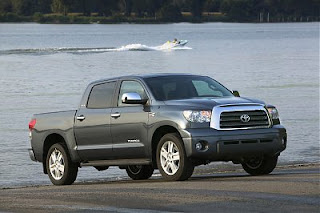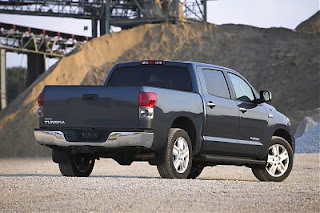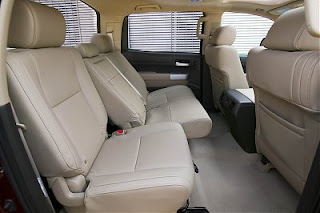2007 Toyota Tundra CrewMax 4×4 Review
By Chris Haak
02.25.2008
Last week, Toyota provided me with a 2007 Toyota CrewMax 4×4 Limited for evaluation. I’ve driven plenty of different pickup trucks over the years – two wheel drive and four wheel drive, basic trim and luxury trim, compact, midsize and full size, regular cab, extended cab and crew cab, gas and diesel, Ford, Chevy and Dodge. However, I’d never spent time in a Toyota truck and was very curious to see if the Tundra – of course, all new and upsized for 2007 (and mostly unchanged for 2008) – could live up to its hype. On paper, it’s certainly an impressive machine. The Tundra is finally as big as or bigger than its domestic competition, and has the towing and payload capacities to match, plus a top powertrain that’s at or near the head of its class.
Exterior From a styling standpoint, the CrewMax is my favorite version of the Tundra. The CrewMax, for those not “in the know,” is one of two four-door versions of the Tundra (the other is called the DoubleCab, which is basically an extended cab, but with shorter forward-hinged doors and hidden handles). The CrewMax is comparable in concept to the Dodge MegaCab pickups, as it has an extremely roomy cab, while sacrificing some cargo box length. It also makes no attempt to disguise the back doors, since they’re longer than the front ones and have same gigantic chrome pull handles. To my eyes, the regular cab Tundras have cartoonishly-large front doors, and the cargo boxes of the non-CrewMax Tundras have too much length between the axle and the front of the box. I believe that the most attractive cargo box proportions occur when the rear axle is centered front to back.
From a styling standpoint, the CrewMax is my favorite version of the Tundra. The CrewMax, for those not “in the know,” is one of two four-door versions of the Tundra (the other is called the DoubleCab, which is basically an extended cab, but with shorter forward-hinged doors and hidden handles). The CrewMax is comparable in concept to the Dodge MegaCab pickups, as it has an extremely roomy cab, while sacrificing some cargo box length. It also makes no attempt to disguise the back doors, since they’re longer than the front ones and have same gigantic chrome pull handles. To my eyes, the regular cab Tundras have cartoonishly-large front doors, and the cargo boxes of the non-CrewMax Tundras have too much length between the axle and the front of the box. I believe that the most attractive cargo box proportions occur when the rear axle is centered front to back.
 Other than overall proportions, the Tundra isn’t a bad looking truck. It applies Toyota’s current truck/SUV styling theme to a large pickup. The theme includes sweeping curves, an oversized grille (somewhat reminiscent of the St. Louis Gateway Arch), and headlights that sweep backward and taillights that sweep forward. There’s a thick character line across the bottom of the doors that really works well. Overall, the truck’s styling is somewhat conservative, but I find it attractive. The 2009 Ram’s look might be marginally more attractive, but the Tundra managed to be conservatively attractive without overdosing on conservatism. (Yes, I’m talking about GM and Ford pickups, which sell in such great numbers that their stewards are afraid to take styling risks. To me, the resulting trucks are too square in an attempt to be “tough.”)
Other than overall proportions, the Tundra isn’t a bad looking truck. It applies Toyota’s current truck/SUV styling theme to a large pickup. The theme includes sweeping curves, an oversized grille (somewhat reminiscent of the St. Louis Gateway Arch), and headlights that sweep backward and taillights that sweep forward. There’s a thick character line across the bottom of the doors that really works well. Overall, the truck’s styling is somewhat conservative, but I find it attractive. The 2009 Ram’s look might be marginally more attractive, but the Tundra managed to be conservatively attractive without overdosing on conservatism. (Yes, I’m talking about GM and Ford pickups, which sell in such great numbers that their stewards are afraid to take styling risks. To me, the resulting trucks are too square in an attempt to be “tough.”)
My test truck was shod with 18 inch wheels and Bridgestone tires, which looked a little small next to the 20 inch wheels that are becoming prevalent in truck-dom, but Toyota does offer the dubs for a reasonable $736. Ground clearance appeared to be appropriate – not too much wheel well was showing (as it did in the mid-1990s Dodge Rams), nor did it sit too low to put the truck’s underside in jeopardy.
Interior
Although full size truck buyers are a brand loyal bunch, and they take great pride in the external toughness of their vehicles, it goes without saying that owners spend far more time inside their trucks than admiring them from a distance. In the past four years (since the introduction of the 2004 Ford F-150), the bar has really been raised in terms of interior material quality, features, and design.
 Against some tough competition, Toyota incorporated some premium features inside the Tundra CrewMax Limited. My test vehicle was nearly loaded, equipped with leather seats, JBL premium audio, factory navigation, four-disc CD changer, Bluetooth cell phone connection, dual glove boxes, dual zone automatic climate control, and multiple storage nooks. My favorite storage compartment is the hanging file holder in the center console – impressive! However, I was disappointed by a few aspects of the interior. The door panels, while they featured a two-tone look (with brown and tan plastic) were entirely covered in plastic with no soft-touch spots. The dashboard itself was surprisingly also entirely hard plastic. It didn’t have a cheap sound when I knocked on it, but I was surprised that the flagship Tundra model would not have a soft dashboard as our Sienna Limited minivan does. I hope that Toyota made that decision based on durability concerns and not cost. The large silver sweep around the instrument panel that goes to the floor console was also rough silver, which again was durable, but reminded me of some rough plastic painted with a can of Krylon Dull Aluminum paint. Against the top-level GM interior, I would give the nod to GM, (having spent 1,200 miles in a Suburban LTZ on a trip to Detroit in January, I’m also familiar with GM’s higher trim levels), though the GMs also have some ill-advised hard plastic touch points. Seats were made with a tougher (less supple) grade of leather than found in most cars, equivalent to the leather GM uses, and were comfortable for two hour-long drives last week.
Against some tough competition, Toyota incorporated some premium features inside the Tundra CrewMax Limited. My test vehicle was nearly loaded, equipped with leather seats, JBL premium audio, factory navigation, four-disc CD changer, Bluetooth cell phone connection, dual glove boxes, dual zone automatic climate control, and multiple storage nooks. My favorite storage compartment is the hanging file holder in the center console – impressive! However, I was disappointed by a few aspects of the interior. The door panels, while they featured a two-tone look (with brown and tan plastic) were entirely covered in plastic with no soft-touch spots. The dashboard itself was surprisingly also entirely hard plastic. It didn’t have a cheap sound when I knocked on it, but I was surprised that the flagship Tundra model would not have a soft dashboard as our Sienna Limited minivan does. I hope that Toyota made that decision based on durability concerns and not cost. The large silver sweep around the instrument panel that goes to the floor console was also rough silver, which again was durable, but reminded me of some rough plastic painted with a can of Krylon Dull Aluminum paint. Against the top-level GM interior, I would give the nod to GM, (having spent 1,200 miles in a Suburban LTZ on a trip to Detroit in January, I’m also familiar with GM’s higher trim levels), though the GMs also have some ill-advised hard plastic touch points. Seats were made with a tougher (less supple) grade of leather than found in most cars, equivalent to the leather GM uses, and were comfortable for two hour-long drives last week.
Ergonomically, controls were easy to understand without much of a thought. Even pairing my Motorola RAZR and BlackBerry 8830 with Bluetooth was a cinch (although I’d already done a similar feat in our Sienna). I also appreciated that the navigation screen was positioned high on the dash, so the driver’s eyes aren’t removed far from the road ahead. However, the ergonomic problem with the interior is that its girth makes it almost impossible to reach the controls – particularly the radio tuning knob – without leaning forward and stretching. I’m 6’4″, so it must be nearly impossible for someone a foot shorter than me to tune the radio manually, at least while the vehicle is moving and the driver is belted to the seat. It seems as if the dashboard designers saw that they had such a large canvas to work with when placing controls, but didn’t consider that the canvas might be too large.
 The back seat of the CrewMax was just awesome. Although I didn’t spend any travel time back there, the flexibility afforded by the extra length allowed me to easily “sit behind myself” (adjusting the driver’s seat to a comfortable position then sitting in the seat behind it). The back seats also are on tracks to slide forward manually as most cars’ front seats allow, and the backrests recline (although I didn’t see any easy-to-use lever to recline them; that is a task best done when the truck is parked). Child seats (both a convertible and a rear facing carrier) installed easily and allowed plenty of clearance to the front seats. My wife commented this morning that the truck was almost too high to comfortably lift our sons into the truck, but that’s not a design flaw, only a consequence of its size and height. The seatbacks also fold forward with just the flip of a lever to make a flat load floor.
The back seat of the CrewMax was just awesome. Although I didn’t spend any travel time back there, the flexibility afforded by the extra length allowed me to easily “sit behind myself” (adjusting the driver’s seat to a comfortable position then sitting in the seat behind it). The back seats also are on tracks to slide forward manually as most cars’ front seats allow, and the backrests recline (although I didn’t see any easy-to-use lever to recline them; that is a task best done when the truck is parked). Child seats (both a convertible and a rear facing carrier) installed easily and allowed plenty of clearance to the front seats. My wife commented this morning that the truck was almost too high to comfortably lift our sons into the truck, but that’s not a design flaw, only a consequence of its size and height. The seatbacks also fold forward with just the flip of a lever to make a flat load floor.
Driving Experience
Knowing that a Tundra was coming to my driveway immediately after the Prius, I knew that both the driving experience and the fuel economy would be drastically different. Talk about an understatement.
The Prius starts with a beep and the engine probably won’t even be running. The Tundra starts with a whir and then the thunderous 5.7 liter V8 kicks in and settles into a baritone idle. The driving experience is very conventional in the Tundra, which I appreciated. Once underway, the best feature of the Tundra quickly became obvious: its powertrain. Not only did the 5.7 liter V8 make great power (381 horsepower and 401 lb-ft of torque), but the six-speed automatic that it was paired with gave me the perfect ratio every time, plus the benefit of quick downshifts when added power was quickly needed (or wanted). Two months ago, I went for a spin in a Jeep Grand Cherokee SRT8 with a 420 horsepower 6.1 liter V8 and five speed automatic; of course, the Tundra is down almost 40 horsepower and up several hundred (if not thousand) pounds on the SRT8, but the Tundra’s V8 and six speed reminded me of the Grand Cherokee. It’s that darn good. It even sounds great. Unfortunately, absolute power corrupts absolutely, and it was just a little too easy to stomp on the gas pedal at whim to enjoy the sounds and the thrust. Merging onto the highway? No problem, give it more gas! Hole opening up in traffic? No problem, give it more gas! Those “give it more gas” situations add up, and over a week and almost 200 miles, I got 12.3 miles per gallon in the Tundra, or 1.7 miles per gallon below its EPA city rating. However, remember that my tester was a 2007, so the 2008 Tundra 5.7 liter 4×4 is rated at 13/17 instead of the 14/18 on my window sticker. Therefore, maybe I didn’t take too many liberties with the big V8, only 0.7 mpg below its 2008 equivalent city rating. The only drivetrain criticism that I have is that when the transmission is in manual mode, upshifts seem to take three times longer than the transmission does on its own. I know I’m going to miss that engine when I go back to my Accord and minivan on Tuesday!
Although I said earlier that the interior wasn’t quite as luxurious or soft as I would have liked in a Limited model, I commend the lack of squeaks, rattles, or wind noise inside while driving. The most prominent sound inside is that V8, but only during acceleration, and it’s fine with me, as the six speed keeps it loping along quietly at less than 2,000 RPMs at 70 miles per hour with no drone.
The truck I tested was equipped with extendable tow mirrors, which are actually an option that has a negative cost, meaning that if you choose it, not only do you get bigger mirrors, but Toyota also gives you a few hundred dollars back, because they’re black plastic and not chromed, and therefore cheaper for Toyota. I probably would have appreciated them more if I had a chance to test the Tundra’s towing, but I did not. I found them difficult to adjust so that blind spots were eliminated (they are at least six inches from the door at the closest point, and the far edges are almost 18 inches from the door, making narrow streets and parking lots hazardous), although a smaller convex mirror underneath the main power adjustable mirror filled in most of the unknowns behind me. Still, I’m glad that I always double check with a head turn before changing lanes, or otherwise I would have mauled a few cars on the road, not to mention the lovely dark green paint of my test vehicle.
My third day with the truck, there was a snowstorm in my area. I brushed off the truck, turned the knob to four wheel drive mode, and headed to work. Toward the beginning of my trip, traffic reports referred to multiple accidents and a vehicle fire on the expressway I usually take, so I took the first exit I got to and made it to work via snowy backroads the rest of the way. The Tundra was a champ in the snow; I felt safe and confident driving it in the white stuff. I wouldn’t call it a “mountain goat,” but I was glad to have a large, heavy, four wheel drive vehicle on my way to work that day.
Bottom Line
The Tundra seemed like a capable, comfortable truck. It has plenty of power and an intelligent, fast-reacting transmission. Although I didn’t tow anything with it or even haul anything in the bed other than some snow that fell into it, most likely many of its buyers won’t either. After all, its 5 1/2 foot bed isn’t very long, and serious truck users probably wouldn’t buy a leather-lined, JBL/navigation-equipped truck with a longer cab than cargo bed. I used it to commute to work and run errands for a week, and at first, I felt self-conscious doing so, thinking I’d have a Ford or GM driver give me the finger for driving a Tundra. That didn’t happen, but then I started thinking about how obnoxious it was for a single driver to commute to work (it’s about 20 miles each way) in a four door, V8-powered pickup truck. Again, no reaction. I had more people giving me odd looks for driving a Prius to work than I did driving the leviathan Tundra to work, and that’s a little sad. If only our planet had unlimited oil, if only gas were $1 per gallon, if only parking spaces were bigger, the Tundra would be the perfect family vehicle. In a way, I’m going to miss driving it, because it’s a lot of fun to have a V8 underfoot, but I doubt there is anyone who needs a vehicle like the CrewMax. There are more spacious family vehicles with more interior volume and much better fuel economy, and there are pickups with cargo boxes much bigger than the CrewMax’s short one, but it really IS a comfortable, capable truck. It’s just not something I’d feel right about driving regularly to my office job.
COPYRIGHT Full Metal Autos – All Rights Reserved




